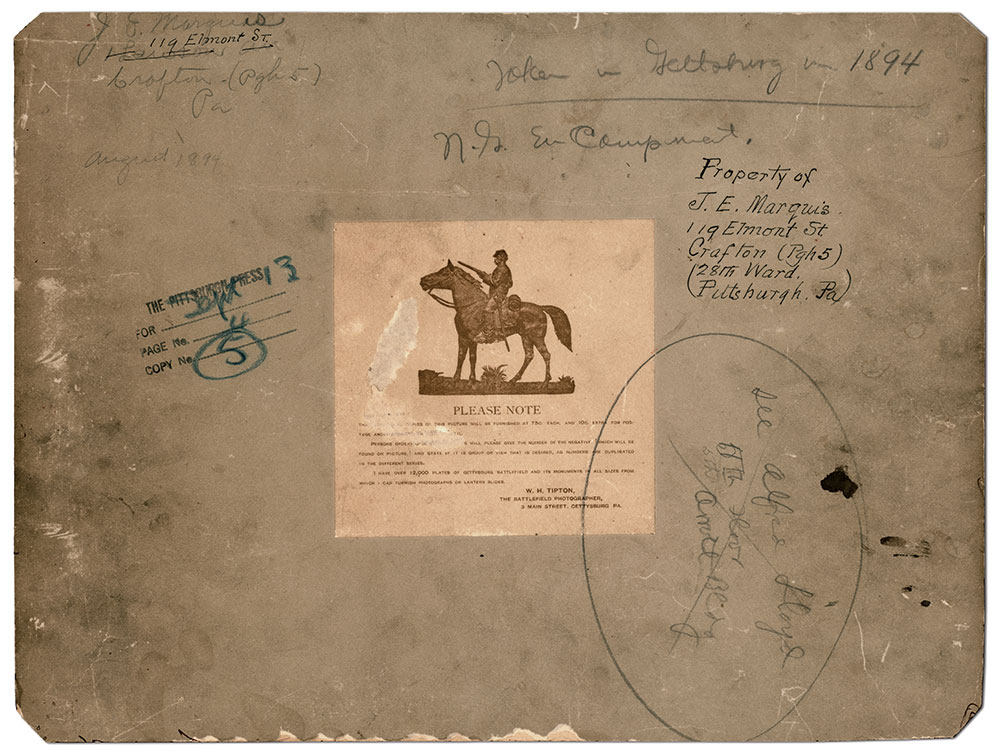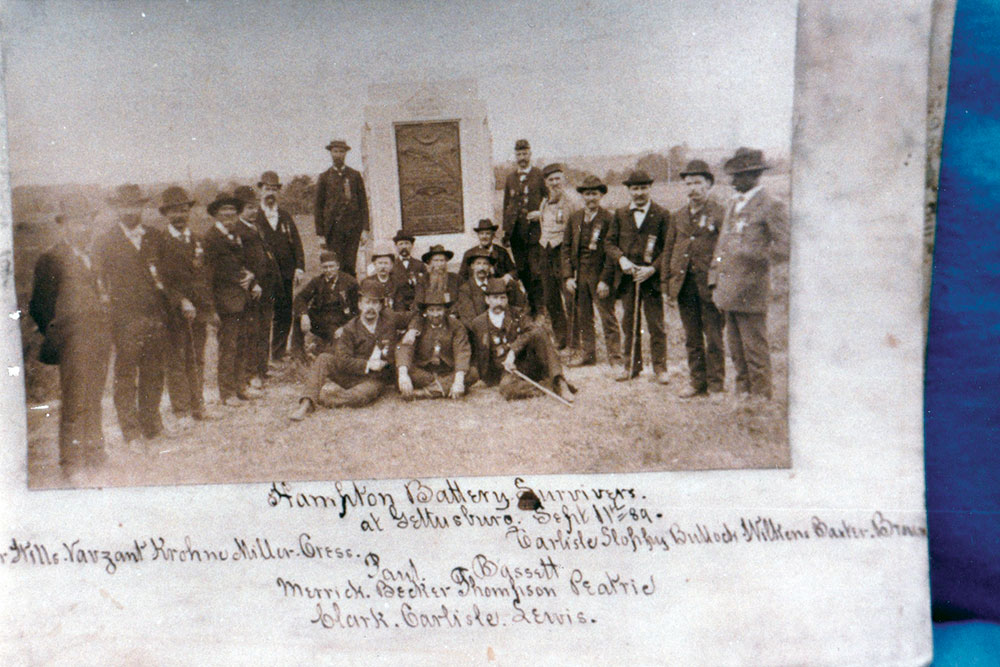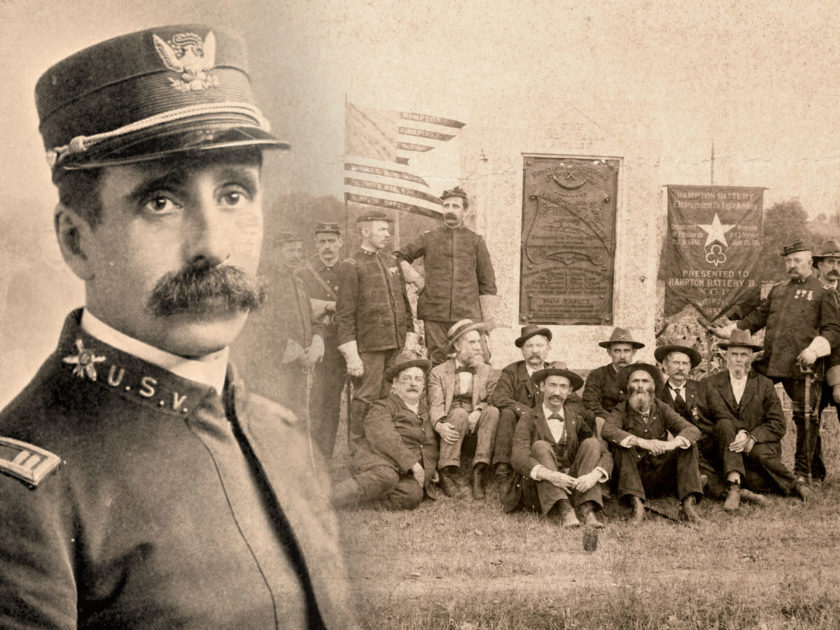By Kurt Luther
In April of this year, the Facebook page “Civil War Pittsburgh,” managed by public historian Rich Condon, posted an intriguing photo of a group of Civil War veterans gathered at a monument at Gettysburg. The photo stood out to me because the veterans were accompanied by a group of uniformed soldiers. Who were these men, and what was their relationship? To answer these questions, I applied photo sleuthing techniques to a post-war view of Civil War veterans and National Guardsmen, a first for this column. Along the way, I identified several of the previously unknown faces, including a Civil War veteran—but not the one I was expecting.
The Photograph
The photo, an albumen print from the Library of Congress, is captioned, “Unidentified Civil War veterans of Battery F Pennsylvania Independent Light Artillery, Hampton’s Battery, at the monument to the combined C & F batteries, Gettysburg.” Just before the Battle of Gettysburg, Batteries C and F, Pennsylvania Independent Light Artillery—both from Pittsburgh—were consolidated into one unit, known collectively as “Hampton’s Battery” in honor of Battery F’s former captain, Robert B. Hampton, recently killed at Chancellorsville. The Hampton Battery, now commanded by Battery C’s Capt. James Thompson, saw significant action at Gettysburg, most notably in the Peach Orchard on July 2, where Pvt. Casper Carlisle later received the Medal of Honor for his efforts to save one of the battery’s guns under heavy fire. A Pittsburgh native myself, I was intrigued to learn more about the mystery photo.


The Library of Congress caption immediately provides some valuable clues by naming the military unit and the location of the photo. However, it also tells us what we do not know—the veterans are unidentified, and soldiers are not mentioned at all. Condon of “Civil War Pittsburgh” had clearly done some preliminary research, for his Facebook post provided additional clues: “Pictured here are veterans of Hampton’s Independent Battery F Pennsylvania Light Artillery, as well as men of Battery B, Pennsylvania National Guard, gathered around their monument on Cemetery Ridge at Gettysburg National Military Park in August 1894. This photograph was taken by W.H. Tipton of Gettysburg, and owned by Private John E. Marquis of Crafton.”
I took a closer look at the photo, which is practically bursting with details and visual clues. Its focal point, a monument erected in 1883, still stands today on Hancock Avenue, and commemorates the Hampton Battery’s actions on July 3. To the right of the monument, a banner titled “Hampton Battery F. Independent Pa. Light Artillery” displays the unit’s Civil War service dates, a II Corps badge below a large star, and the subtitle, “Presented to / Hampton Battery B. / N. G. P. March 24th / 1892.” On the left is a guidon with similar text. Surrounding the monument are 22 men, some wearing civilian clothing and reunion badges and others in 1880s-era army uniforms and equipment.
The back of the photo is covered with inscriptions offering still more leads. A prominent backmark identifies the photographer as the prolific William H. Tipton of Gettysburg, whose studio operated from 1868 to 1925. Two penciled inscriptions date the photo. One reads, “Taken at Gettysburg in 1894 / N. G. Encampment,” while the other simply reads, “August 1894.” Two other inscriptions identify the photo’s owner as one J. E. Marquis of 119 Elmont St., Pittsburgh. An additional inscription reads, “see Alfred Lloyd.” Finally, an ink stamp for The Pittsburgh Press, a local newspaper, includes the date “Sept 13.”
The first question to resolve is the photo’s date. The photo offers two promising leads: March 24, 1892 (from the banner and guidon), and August 1894 (from the inscriptions on the back). I turned to the battery’s regimental history, published in 1909 by William Clark, secretary of the Hampton Battery Veteran Association. The book is available online from the Internet Archive. But to my frustration, the two pages covering the year 1892 were inexplicably missing from the digitized text. Luckily, I found another copy on Google Books that contained the full story.

In September 1891, Capt. Alfred E. Hunt, commander of Battery B, Second Brigade, Pennsylvania National Guard, sent a letter to the Hampton Battery Veteran Association requesting that they “allow the name of ‘Hampton Battery’ to be taken up by the present light artillery organization located in the western part of the State of Pennsylvania.” The Veteran Association promptly agreed and formed a committee to work out the details. In a ceremony on March 24 of the following year, according to the Pittsburgh Daily Post, 14 veterans of the original Hampton Battery attended the spring inspection of Battery B and bestowed the honorary name, along with two gifts—“a beautiful guidon and a banner inscribed with the record of the Hampton battery”—both visible in our mystery photo. This event, however, took place at the battery’s armory in Pittsburgh, not Gettysburg, so we can rule it out as the date of the photo.
That leaves August 1894 as the most promising alternative. I wondered what other notable events might bring the two groups together at Gettysburg. Fortunately, Wikipedia provided a remarkably direct answer to that question with its crowdsourced “List of Gettysburg Battlefield camps after the American Civil War.” On Aug. 11, 1894, the Pennsylvania National Guard held an encampment at Gettysburg, named “Camp Samuel W. Crawford” in honor of the Pennsylvania Reserves’ commander. This is undoubtedly the “N. G. Encampment” referenced on the back of the mystery photo.
Following this lead, I wondered what exactly happened during the encampment where the mystery photo was taken. The trip is surprisingly well-documented. An 1899 article in The Pittsburgh Press recalled that 12 veterans of Gettysburg and the original Hampton Battery attended the camp as guests of Capt. Hunt, still commanding Battery B. One morning, the veterans took a ride with Hunt’s men in their gun carriages to the base of Little Round Top. The veterans, who had defended the top of that hill three decades earlier, asked Hunt to fire a cannon shot. The captain complied, though apparently it was no easy task getting the guns up through the trees. “Once there,” the article notes, “the pieces were unlimbered on the very ground where the old battery stood and a national salute was fired.”
The Guardsmen
At some point on this trip, the men gathered by the Hancock Avenue monument for Tipton to take their picture. Now that we can date this photo, I focused my analysis on identifying the soldiers. The 10 soldiers present wear the uniforms of the Pennsylvania National Guard, featuring keystone-shaped collar insignia and kepis bearing the crossed-cannon insignia with the letter “B,” and all are equipped with swords. Eight soldiers stand to the left of the monument, and two to the right. Five appear to be NCOs. The other five are officers, whose shoulder straps indicate two first lieutenants and two second lieutenants. The fifth’s shoulder straps are indeterminate, but show at least one bar. However, his central position in the photo directly beside the monument and his authoritative bearing suggest he is the group’s leader.
I suspected that this officer was Capt. Hunt, given his dual roles that day as both commander and host. Alfred Epher Hunt was, by the time of this photo, a prominent citizen of Pittsburgh. Born in Massachusetts in 1855, he earned an engineering degree from the Massachusetts Institute of Technology (MIT) and established himself in Pittsburgh as a leading businessman and expert in mining and metallurgical engineering of international repute. He also had extensive military experience. By one account, he was a nephew of the Army of the Potomac’s chief of artillery, Henry J. Hunt, spending time in camp and “seeing active service, though only a boy.” He served in several National Guard units and, as a testament to his leadership, was promoted directly from private to captain on more than one occasion, including his current command of Battery B.
Clark’s aforementioned regimental history includes a portrait of Hunt in uniform. His face is a perfect match for the presumed captain standing beside the monument.
With Hunt identified, we turn to the other four officers in the picture. First, we need their names. The “Report of the Adjutant General of Pennsylvania” for 1894 identifies six officers for Battery B, including Hunt. Next, as with Hunt, we need to find identified reference images for these names and compare them to the faces and uniforms of the officers in the photo. Portraits of 1880s-era National Guard officers can be hard to come by, but The Pittsburgh Press article conveniently includes hand-drawn portraits of three officers of Battery B in 1899 whose service dated back to 1894 or earlier. In another stroke of luck, two of them, both named “Alfred,” map onto Battery B’s only second lieutenants. One, Alfred W. Marks, resembles the second lieutenant standing to the right of the monument. The other is Alfred G. Loyd, whose name was scrawled on the back of the mystery photo.
The remaining two unidentified officers are first lieutenants. Unfortunately, the Adjutant General report lists three first lieutenants, so apparently one is not pictured, hindering our process of elimination. The third Pittsburgh Press portrait depicts one of them, Edward Eichenlaub, who appears standing left of the monument. The other first lieutenant could either be James L. Srodes or Lewis T. Brown. Since both men left Battery B prior to 1899, neither has a hand-drawn portrait in The Pittsburgh Press article, so I expanded my search of imagery to other reference materials. Srodes’ portrait is available on the website for the Pennsylvania House of Representatives, in which he served one term of office. Brown was eventually promoted to chief of ordnance, and he served on the Pennsylvania Commission for the Fiftieth Anniversary of the Battle of Gettysburg, in whose final report his portrait appears. Unfortunately, both Srodes and Brown look like the remaining unidentified first lieutenant, who is older, barrel-chested, and mustachioed, so a facial comparison cannot rule out either man.
Hitting this roadblock, I stared at the final unknown officer in the photo, trying to discern any clue that could get me unstuck. My eyes were drawn to the row of three medals pinned to his chest. Most of the soldiers wore a medal or two, but I did not recognize their shapes. One of these three, however, looked familiar. Eagle, ribbon, star. Suddenly, it dawned on me: it was a GAR medal! This officer was also a Civil War veteran.
I excitedly pulled up the Adjutant General report, which includes columns for prior military service. Srodes’ service began in 1889. Brown, however, spent two and a half years as a private in the 102nd Pennsylvania Infantry, another Western Pennsylvania unit that served at Gettysburg. The first lieutenant proudly bearing his GAR medal must be Lewis T. Brown.
I had hoped also to identify the non-commissioned officers in the photo. But this proved difficult, as many of their chevrons were obscured, and some of Battery B’s NCOs were apparently not present. The soldier on the far left wearing a hospital steward’s cap badge is likely Thomas W. Wallace, who held that position in the battery. But the others are hard to determine. The 1894 Pittsburgh Press article indicates that Battery B’s commissary at the time was John E. Marquis—owner of our mystery photo. He may be among the NCOs pictured here.
The Veterans
Likewise, I struggled to identify any of the Civil War veterans in the photo. There are 12 men in civilian clothing, matching the 1899 Pittsburgh Press account of Capt. Hunt escorting a dozen veterans. Eight of the men sit in front of the monument, and four stand to its right. One wears a GAR medal with a shoulder strap bearing oak leaves, indicating he is a current elected officer at either the post or department levels. Another wears a GAR medal and a reunion badge matching the star-and-trefoil design on the right-side banner. Most wear a lapel pin resembling a shield, though at least one is a star. To identify any of them, especially out of uniform, I would need contemporary identified reference imagery.

Only four reference images of identified Hampton’s Battery members can be found in the online databases of the American Civil War Research Database (HDS) and Civil War Photo Sleuth. Three of these soldiers did not survive the war. Broadening my search, I found a website for Hampton Battery F, a living history group, which included a copy print of an earlier photo of the original Hampton veterans surrounding the same monument. The creation of this photo, dated Sept. 11, 1889, five years before our mystery photo, is thoroughly documented in Clark’s regimental history. After Veteran Association member George V. Marshall took the photo, the group walked to the Peach Orchard to select the site for the battery’s individual July 2nd monument that has stood since 1893. Remarkably, all 22 veterans pictured are identified in a handwritten caption, including Medal of Honor awardee Casper Carlisle—perhaps his only known photo. Robert J. Brown, leader of the reenacting group, and his son, James, provided a high-resolution digital scan, but unfortunately, the copy print is too blurry to allow for accurate facial comparison to the mystery photo. Perhaps the original will surface.
The soldiers of Hampton Battery B found themselves on the field of battle only a few years after. On April 25, 1898, the United States declared war on Spain, and Battery B’s six officers and 116 men answered the Governor of Pennsylvania’s call to duty. Four of the five officers pictured at the Hampton Monument—Hunt, Eichenlaub, Marks and Loyd—and the photo’s owner, Marquis, were among them. With the Veteran Association aiding recruitment, the battery grew to full strength and commanded four 3.2-inch breech loading rifles. The battery shipped to Puerto Rico in August and participated in the campaign there, including the capture of the towns of Arroyo and Guayama. In mid-September, a few weeks after hostilities ceased, the battery returned to Pittsburgh, where it was welcomed by a committee of the Veteran Association and a parade.
Epilogue
In his original request to the Veteran Association in 1891, Capt. Hunt wrote that “should our Battery ever be called into service,” his men would “carry out the proud record which the old Hampton Battery has made for itself.” Seven years later, he delivered on that promise. Hampton Battery B had preserved its namesake’s honor in the Spanish-American War, but not without cost. The debilitating illnesses of the campaign lingered with some of the men. A few days before mustering out, the battery’s first sergeant, Samuel Stewart, died of pneumonia, according to the regimental history.
Captain Hunt found his own health worsening. On April 26, 1899, a year and a day after the commencement of the war, Hunt died at age 44 from complications of malaria, leaving behind a wife and a son. His headstone in Pittsburgh’s Allegheny Cemetery, not far from that of Capt. Robert Hampton, bears the epitaph, “For the extension of the principles of liberty for which our Republic stands we should be ready to sacrifice. If need be, life itself.”
Kurt Luther is an associate professor of computer science and, by courtesy, history at Virginia Tech. He is the creator of Civil War Photo Sleuth, a free website that combines face recognition technology and community to identify Civil War portraits. He is an MI Senior Editor.
SPREAD THE WORD: We encourage you to share this story on social media and elsewhere to educate and raise awareness. If you wish to use any image on this page for another purpose, please request permission.
LEARN MORE about Military Images, America’s only magazine dedicated to showcasing, interpreting and preserving Civil War portrait photography.
VISIT OUR STORE to subscribe, renew a subscription, and more.

